Podcast
Questions and Answers
How do tetracyclines enter susceptible organisms?
How do tetracyclines enter susceptible organisms?
- Passive diffusion through the mitochondrial membrane
- Active transport through mammalian ribosomes
- Passive diffusion only
- Active transport through the bacterial inner cytoplasmic membrane (correct)
What is the mechanism of action of tetracyclines?
What is the mechanism of action of tetracyclines?
- Destroys bacterial cell walls
- Prevents binding of tRNA to the mRNA-ribosome complex (correct)
- Inhibits DNA replication in bacteria
- Disrupts bacterial cell membrane integrity
What is the antibacterial spectrum of tetracyclines?
What is the antibacterial spectrum of tetracyclines?
- Effective only against gram-positive bacteria
- Effective against fungal infections
- Effective against a wide variety of organisms including gram-positive and gram-negative bacteria, protozoa, spirochetes, mycobacteria (correct)
- Effective primarily against viral infections
Why do high concentrations of drugs such as chloramphenicol or tetracyclines cause toxic effects in mammalian cells?
Why do high concentrations of drugs such as chloramphenicol or tetracyclines cause toxic effects in mammalian cells?
What is the primary reason for the selectivity of protein synthesis inhibitors for bacterial ribosomes?
What is the primary reason for the selectivity of protein synthesis inhibitors for bacterial ribosomes?
Flashcards are hidden until you start studying
Study Notes
Tetracycline Uptake
- Tetracyclines enter susceptible organisms through an energy-dependent active transport process, which involves a proton motive force that drives the uptake of the antibiotics.
Mechanism of Action
- Tetracyclines inhibit protein synthesis by binding to the 30S ribosomal subunit, preventing the attachment of aminoacyl-tRNA to the ribosome.
- This binding inhibits the initiation of protein synthesis, ultimately leading to cell death.
Antibacterial Spectrum
- Tetracyclines are broad-spectrum antibiotics, effective against a wide range of bacteria, including Gram-positive, Gram-negative, aerobic, and anaerobic bacteria.
- They are also effective against some protozoa, such as Plasmodium, and certain parasitic infections.
Toxic Effects on Mammalian Cells
- High concentrations of tetracyclines, as well as chloramphenicol, can cause toxic effects in mammalian cells due to their ability to inhibit mammalian protein synthesis, particularly in mitochondria.
- This is because these antibiotics can bind to mammalian mitochondrial ribosomes, which are similar to bacterial ribosomes.
Selectivity of Protein Synthesis Inhibitors
- The primary reason for the selectivity of protein synthesis inhibitors, such as tetracyclines, for bacterial ribosomes is the differences in ribosomal structure and function between bacteria and mammals.
- This selectivity allows these antibiotics to target bacterial protein synthesis without significantly affecting mammalian protein synthesis.
Studying That Suits You
Use AI to generate personalized quizzes and flashcards to suit your learning preferences.




